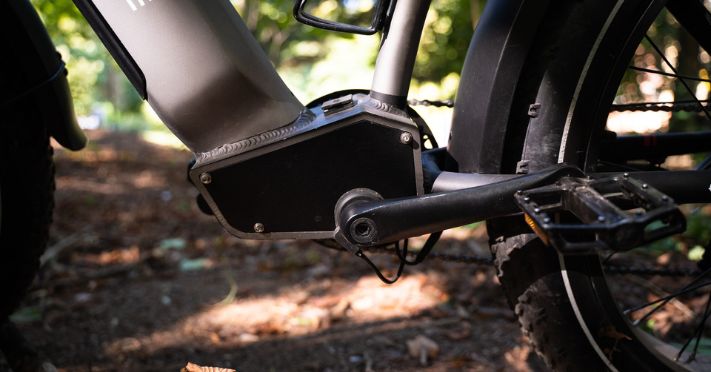Zooming through the streets with the wind in your hair and conquering hills without breaking too much of a sweat – that’s the magic of e-bikes! Since Yamaha planted the seed in 1993, these electrified wonders have taken the cycling world by storm, offering us a taste of the future while pedaling through the here and now.
But hold on tight, because there’s more to these marvels than meets the eye. To help uncover the mystery of pedal assist systems (or PAS), we present this electric bike motor guide.
Let’s dive into an e-bike motor comparison, where cadence and torque sensors are taking center stage. By the end of this ride, you’ll be armed with the knowledge to decide on a motor that matches your style and ambition.
Understanding E-Bike Motors: Unveiling the Power Within
What is a Cadence Sensor Motor?
Let’s start this e-bike motor expedition with the cadence sensor motor. Picture this: You’re pedaling along while a gentle, invisible force helps push you forward. That’s the cadence sensor motor at work. It senses the rhythm of your pedaling and assists in making your ride smoother and more enjoyable.
Mechanics of Cadence Sensor Motors
Think of the cadence sensor motor as a trusty co-pilot. Responding to how quickly you pedal and giving you a consistent boost, smoothing out the rough patches of your journey. Going uphill? No problem. The motor has your back, ensuring that the climb feels like a breeze.
The basic cadence sensor operates on a switch that’s triggered by a magnet on the crank. When you start pedaling, it shouts, “Let’s roll!” and when you stop, it’s all, “Time-out!”
But here’s the cool part: you’re the boss of the assistance level. It’s like being in control of your bike’s mood – you can kick it up a knotch or keep it chill by adjusting those assist levels up and down, effectively giving you more or less power depending on your need.
Cadence Sensor Advantages
Cadence sensor motors are the laid-back buddies of the industry. They’re great for leisurely rides around town, daily commutes, and scenic routes where you want a steady, hassle-free ride. These motors offer a straightforward and user-friendly experience, making them perfect for riders of all skill levels.
Potential Drawbacks
Every rose has its thorn, and cadence sensor motors might not be the best match for thrill-seekers craving precise control, especially when navigating tricky terrains or steep inclines. Their consistent help may not cater to the dynamic demands of specific riding scenarios.
Another potential downside is that with standard cadence sensor motors, you’re going to feel the full force of the chosen pedal assist level. So, if it’s set to the highest level, it can feel too strong and jarring. On the flip side, if it’s set too low, you may not get enough assistance, making your ride a lot more challenging than it needs to be.
What is a Torque Sensor Motor?
Get ready to meet the torque sensor motor, the e-bike equivalent of having a personal cheerleader. This motor reacts to the amount of force you apply to the pedals. It’s like riding with a built-in teammate who matches and multiplies your effort – say hello to effortless uphill battles!
Mechanics of Torque Sensor Motors
The torque sensor motor is a master of adaptation. It understands the effort you’re putting into your pedal strokes and syncs its assistance with your energy, giving you a more natural e-bike riding experience. It’s the secret sauce to amp up your biking mojo.
Torque Sensor Benefits
Torque sensor motors are the dream companions of avid adventurers and those who want the closest thing to traditional biking with an electrified twist. If you’re tackling rough terrains or demanding trails, this motor type enhances your power, giving you the push you need to conquer any challenge.
Limitations to Consider
No superhero is without their kryptonite. Torque sensor motors demand a little more engagement and effort from the rider, which might not suit those looking for that completely laid-back ride. Also, remember that this particular kind of magic will often come with a higher price tag.
Difference Between Cadence and Torque Sensors
Performance and Efficiency
Gearheads and efficiency aficionados, listen up. When it comes to performance, cadence sensor motors are your steady companions, offering consistent assistance across various terrains.
Conversely, torque sensor motors are like a personal fitness trainer, adapting their support based on your pedal prowess (potentially extending your battery life).
Natural Riding Feel
Want to feel like you’re cruising on a traditional bike with some pep in its step? Torque sensor motors deliver that natural biking experience you crave. On the other hand, cadence sensor motors might feel a tad more mechanical, offering reliable assistance but without that extra sprinkle of biking enchantment.
Cost Implications
Now, onto the big discussion – e-bike motor price difference.
Cadence sensor-equipped e-bikes are like your budget-friendly buddies who still know how to have a blast. They offer an economical entry point into e-biking.
Meanwhile, torque sensor-equipped bikes might require a bit more financial commitment, but the enhanced riding experience could make it worth every penny.
Longevity and Maintenance
In a longevity showdown, both motor types can be very dependable partners when cared for properly. However, cadence sensor motors might hold a slight advantage due to their simpler mechanics. On the flip side, torque sensor motors, while more advanced and thrilling, could potentially require a bit more maintenance over time.
Performance and Efficiency
- Cadence sensor motors provide consistent assistance across terrains.
- Torque sensor motors adapt support based on your pedaling, potentially extending battery life.
Natural Riding Feel
- Torque sensor motors offer a natural biking experience.
- Cadence sensor motors feel somewhat mechanical, lacking a touch of biking magic.
Cost Implications
- Cadence sensor-equipped e-bikes are more budget-friendly.
- Torque sensor-equipped bikes may require a higher investment for an enhanced experience.
Longevity and Maintenance
- Cadence sensor motors have simpler mechanics and may offer an advantage in longevity.
- Torque sensor motors, while advanced, may require more maintenance over time.
Making the Right Choice for Your E-Bike Needs: Navigating Your Motor Odyssey
Consider Your Terrain
Imagine confronting a mountain trail’s towering climb. Your heart races, and your bike’s ready for the challenge. If this scenario pumps you up, the torque sensor motor is the choice for you. It’s an unwavering ally against gravity’s pull, responding to your pedal force with a calibrated power boost. Whether on steep inclines or rugged paths, it creates an intuitive riding experience for conquering those tricky terrains.
Now, shift gears to a different scenario. Imagine meandering through charming town streets or gliding along tranquil park pathways. Here, the focus isn’t on conquering peaks but on savoring the ride itself. In these leisurely moments, the cadence sensor motor shines. It provides a seamless and steady assist, akin to a gentle breeze guiding you along.
Factor in Your Riding Style
Are you the laid-back explorer or the trail-taming conqueror? If leisure rides and daily commutes are your jam, a cadence sensor motor could be your perfect match. If you’re the type who seeks adventure on unpredictable paths, a torque sensor motor might be calling your name.
Range and Battery Efficiency
The choice between torque and cadence sensor motors can significantly impact your journey’s range. Torque sensor-equipped e-bikes will generally take the lead when compared to their cadence sensor cousins. Overall range also has a lot to do with the specs of the installed e-bike battery. But, the secret lies in how these sensors interact with your pedal power and the motor’s assistance.
Torque sensors make you an active partner in the ride. As you pedal, they respond with a finely tuned boost that complements your effort, reducing the motor’s workload (waste not, want not). This harmony conserves energy, helping you enjoy some extra miles.
On the other hand, cadence sensors engage the motor with a simple pedal spin, but heavy and consistent use of the highest pedal assist level demands more from the motor, draining the battery at a much quicker rate.
So, whether you’re conquering peaks or savoring city streets, your sensor choice becomes a key player in e-bike motor efficiency.
Think About Your Budget
If you’re ready to dip your toes in without breaking the bank, cadence sensor-equipped e-bikes offer a more economical entry point. However, if you’re ready to spend a little more for an electrifying adventure that matches your biking aspirations, a torque sensor-equipped e-bike could be the ticket.
Final Thoughts
As we roll toward the end of our e-bike motor expedition, remember this: the choice between cadence and torque sensor motors isn’t just about gears and gadgets. It’s about finding the ride that amplifies the joy of biking and aligns with your spirit of adventure. So, fellow pedal pushers, before you take the leap, hop on a test ride and let the motors whisper those sweet nothings in your ear.
Whether you’re conquering peaks, exploring the city’s heart, or simply enjoying the wind in your hair, your e-bike motor is your trusty partner, propelling you to new horizons. Embrace the exhilaration, make your choice, and embark on a journey that’s as electrifying as the motor powering it.



